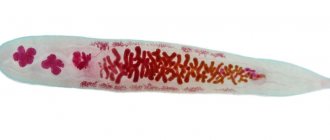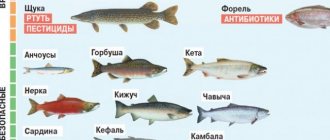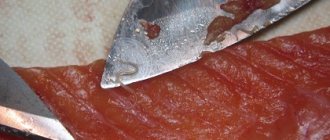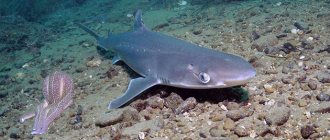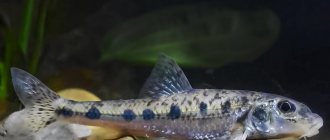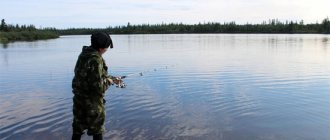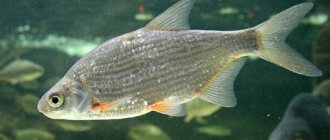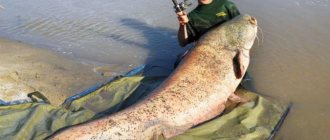3229
0
Parasites will come out like scalded ones if you drink in one gulp...
Mountains of parasites will come out of you if you drink the usual gulp on an empty stomach...
Go to website
Opisthorchiasis is a helminthic infestation that is widespread in our country due to the abundance of natural areas where O.felineus exists, in other words, the cat fluke. This type of trematode is a biohelminth, that is, during the development process at each intermediate stage, this parasitic life form requires an intermediate carrier. The first carrier is a freshwater mollusk belonging to the genus Codiella. The second intermediate carrier is freshwater fish. Is there opisthorchiasis in pike and can you get opisthorchiasis from eating pike?
What fish has opisthorchiasis?
As we mentioned at the very beginning, freshwater fish acts as an intermediate carrier of opisthorchiasis. As experts note, this type of trematode is observed exclusively in cyprinid fish. Prominent representatives of this family are: roach, ide, roach, bream, gudgeon, dace, carp, rosemary, crucian carp, ram, bleak, carp, tench, minnow, bluegill and others.
However, recent studies have shown the presence of O.felineus metacercariae (the larval form of the cat fluke, capable of existing in the body of the final host, which is often a human) in freshwater fish that do not belong to the cyprinid family. The presence of parasite larvae is noted in vendace, chekura, cheese, and muksun.
What is this connected with? It is believed that this is due to the existence of these fish in epidemiological areas, that is, in natural foci of opisthorchiasis. This includes the basins of the following rivers: Ob, Volga, Irtysh, Kama, Dnieper, Don, Biryusa, Ural, Northern Dvina and even Yenisei. Freshwater fish, especially the carp family, living in the natural focus of opisthorchiasis, are infected with opisthorchiasis with a probability of about 90%.
Does pike have opisthorchiasis? Let's find out.
Prognosis and prevention
Opisthorchiasis can be called a disease that is easier to prevent than to deal with its consequences. To do this, it is enough not to eat insufficiently processed fish and meat of wild animals. You should avoid eating stroganina and lightly salted fish. Parasites can be destroyed not only by heat treatment, but also by cold. It is enough to freeze the product at a temperature of -28 C for 32 hours.
Boil and fry medium pieces of fish for at least 20 minutes. Depending on the size, pickle for 10 - 40 days. Dry for at least 2 weeks. Hot smoking can kill the parasite at a temperature of +70 C for at least 2 hours.
go to analyzes
Can pike be infected with opisthorchiasis?
DOCTORS RECOMMEND!
Pinworms, Giardia, tapeworm, helminths, tapeworm... The list goes on for a long time, but how long are you going to tolerate parasites in your body? But parasites are the main cause of most diseases, from skin problems to cancer. But the chief television doctor of Russia, Sergei Agapkin, assures that it is easy to cleanse your body even at home, you just need to drink... Read more »
Modern scientific research has proven the likelihood of cat fluke metacercariae being carried by pike. This is due to its predatory diet. When a pike eats fish infected with opisthorchiasis, metacercariae of the cat fluke enter its body. Considering the high level of infection of freshwater fish in the epidemiological regions of our country, pike living in the basins of the above-mentioned rivers invariably eat infected fish.
Consequently, there is opisthorchiasis in pike. Everything seems quite logical. However, it should be understood that when the final host enters the body, the metacercariae emerge from the cysts and after some time transform into an adult, which begins to lay eggs and feed.
In the body of the final host, the adult is localized in the ducts of the liver, gall bladder or pancreas. The existence of the cat fluke has not been noted in other locations. This can be explained by the optimal conditions provided by the body's hepatobiliary system.
It is worth noting a key element that casts doubt on the likelihood of the existence of opisthorchiasis in the body of pike. This element is the bile juice of this predatory fish. Traditional medicine uses pike bile for opisthorchiasis. It is believed that the enzymes contained in the bile of this fish are unbearable for the cat fluke, so pike bile is used as a medicine in the treatment of this trematode.
Based on this, it turns out that the existence of O.felineus in pike is impossible, or the metacercariae of the parasite do not emerge from the cysts and “wait” for the pike to be eaten by a person or other piscivorous animal. However, when the metacercariae of the cat fluke enter the stomach, digestive enzymes affect the release of the larvae from the cysts; in other words, the cysts are destroyed under the influence of gastric juice.
It should also be understood that there is, in fact, no scientific data on the negative impact of pike bile enzymes on cat fluke. Therefore, it is not possible to refute or prove this “theory”.
Does pike suffer from opisthorchiasis? There is no clear answer to this question, since there is reason to believe that consumption of pike can cause a person to become infected with opisthorchiasis, and there is also reason to believe that this is impossible. Consequently, there are two fundamentally different points of view on this issue and each of them has its own supporters.
From my subjective point of view, the possibility of the presence of metacercariae of the cat fluke, as well as an adult individual, in pike should not be excluded, but that is not the point. It is reliably known that this species of freshwater predatory fish is an intermediate carrier of the broad tapeworm, which can also carry out parasitic activity in the human body, causing diphyllobothriasis. The broad tapeworm belongs to the class of cestodes (tapeworms) and is less dangerous than the cat fluke, but it can also bring many unpleasant “surprises”.
Therefore, in this matter it does not matter at all whether the pike has opisthorchid or not. It is important to understand that any fish, especially freshwater, must be properly cooked before consumption.
Prevention of opisthorchiasis
It was found out which fish contain parasites. Unfortunately, it is not possible to find out at home which fish is sick and which is not, even if you know the information about which fish you can get infected from.
What does opisthorchiasis look like? It will not be possible to see parasites with the naked eye, even if there are a large number of them in the fish, so you need to take it as an axiom that any fish contains helminths, and strictly follow the rules for processing fish.
Helminth larvae are particularly resistant to low and high temperatures, and are quite capable of maintaining their viability for a long period of time.
How to get rid of helminths by freezing:
- At a temperature of 7-10 degrees, you need to freeze fish for 20 days, no less.
- At a temperature of 18 degrees for 10 days.
- And at a temperature of 20 degrees, the larvae will die within 3 days.
Salting fish products is a common way of preparing fish. However, not everyone knows how many days it takes to salt fish so that all the larvae die. It is known that salt can kill parasites, so the process of salting a fish product is as follows:
- Cut the fish into small pieces, rinse each piece under running water, and remove excess moisture with paper towels.
- Sprinkle each piece with salt without adding water.
- Thus, the process of salting fish is carried out through its own juice.
- It will be possible to eat only on the fifth day of salting.
It is worth noting that heat treatment of fish does not always kill parasite larvae. To be absolutely sure that fish fillets are disinfected, large fish are always cut into small portioned pieces, and they must be boiled for at least half an hour. When frying, the cooked product is covered with a lid, which increases the likelihood of getting rid of the larvae.
Stroganina is a very popular dish in the northern regions, but it carries great danger and a serious risk of parasite infection. Therefore, it is recommended to avoid eating raw fish to protect not only yourself, but also your family.
Recommendations for cleaning and cutting fish:
- If helminths are found in fish, it must be thoroughly washed under running water and the entrails must be removed.
- It is not always possible to find out whether fish have opisthorchiasis, so it is recommended to have a separate cutting board and knife for fish products.
- After cutting the fish, all the dishes in which the fish fillet was located are washed several times with detergent and then doused with boiling water.
It is advisable to note that domestic animals are also susceptible to parasitic diseases; as a result of their infection, helminths are also found in humans. Therefore, in order not to learn in practice what opisthorchiasis is, prevention should also be carried out in relation to the nutrition of domestic animals.
In any case, if a person doubts whether he can eat fish or not, it is better to refuse the delicious delicacy in order to preserve his health and the health of his household.
Opisthorchiasis is also called a disease of pleasure, and this is true. After all, many people like to pamper themselves with delicious fish dishes, but the cooking technology does not always include proper heat treatment. Which is the main cause of infection.
You should always remember about the possibility of infection, and the consequences arising from it depend solely on the person himself. A permissive attitude towards one's health in the vast majority of cases leads to negative future consequences. Therefore, you need to take care of your health and prepare fish products wisely.
A parasitic disease caused by a representative of the flatworms Fluke, which can be obtained by eating raw or poorly processed fish, is called opisthorchiasis.
Opisthorchiasis of carnivores is a helminthiasis that affects carnivorous animals (representatives of the families felines, canines, pigs, etc.) and humans, causing damage to the liver, biliary tract and pancreas.
How to distinguish a sick pike from a healthy one
We figured out that there is a possibility of pike being infected with opisthorchiasis. Now let's talk about how to determine whether there is a worm “living” in a pike or not.
To determine the infection of this predatory fish, you should carefully study its appearance, since a thorough examination can reveal the following criteria:
- Cloudy eye pupil (lens), the mucous membrane of the organ of vision is excessively dry;
- Easy removal of the scaly covering of the body. In this case, there is a slight presence of sticky mucus;
- The belly of a predatory fish is disproportionately swollen and saggy;
- Obvious muscle softness even after the death of the fish. When you press on the body, the resulting hole is not restored;
- When cutting pike, the internal organs have a strong unpleasant “aroma”;
- The color of the gills resembles that of a swamp;
- The anus of predatory fish is excessively convex and secretes mucus;
How to properly process fish
Opisthorchiasis fish is treated with cold and heat. A concentrated solution of table salt helps rid river fish meat of worms.
Freezing
When freezing fish, opisthorchid larvae die only at –10°C, but this is provided that the product is stored in the freezer for a week. To rid carcasses of the liver fluke within three days, it is necessary to reduce the temperature to –25°C.
Heat treatment
When asked at what temperature opisthorchids die in fish, experts answer that fluke (liver fluke) larvae do not die at a temperature of +40°C. They need heat treatment at a higher temperature - boiling, smoking, cooking or baking at 100°C.
Pickling
The most unreliable way to get rid of worms from a product. The question of how much salt fish needs to be salted to kill opisthorchiasis should be given careful attention. Inside small fish (less than 25 cm long), the larvae can survive even after two weeks of salting. Therefore, large carcasses must be kept in a salt solution for more than 30 days. The brine is prepared at the rate of 270 g of salt per 1 kg of fish.
Drying
When dried, fish meat is no less dangerous to health than after salting. Therefore the treatment should last about 3 weeks.
How to kill opisthorchiasis by drying:
- The fish are left in salt for 2-3 days; the salting period depends on the size and weight of the carcasses. Use 12-14% salt by weight of the carcass.
- Fish carcasses are dried for 2-3 weeks.
Other methods
Additional methods for disinfecting fish from larvae:
- Worm larvae settle not only in the caviar and liver, but also on the back and belly under the fins, in the gills, and in the eye sockets of the fish, so when cutting its head and fins it is better to immediately cut it out.
- Fish pieces should be fried by pouring plenty of vegetable oil, covering with a lid, making a cut along the ridge.
- It is recommended to steam fish in portions, approximately 150 g each.
- Pies with fish filling should be baked for about 30 minutes.
How to eliminate helminthic infestation when consuming pike
Warning
Herman Gandelman: “Halitosis is a very bad signal, 98% that you have parasites! To drive them out, you need a regular…” Read more »
It is important to understand the likelihood of the presence of predatory fish in this species not only of the broad tapeworm, but also of many other parasitic worms and their larvae. So that you understand the scale of fish parasitic diseases, according to statistics, absolutely any freshwater fish can become a source of infection with helminthic infestation, including opisthorchiasis, clonorchiasis, nanophyetosis, etc. In addition, it is not always possible to distinguish sick fish from healthy ones.
The possibility of helminthiasis infection can be eliminated through proper preparation and storage of pike. Preparation consists primarily of heat treatment of the pike:
- When fresh fish is boiled for half an hour, all parasite larvae, including the parasites themselves, die. First you should cut the carcass into slices. This is especially true for large pike. Small fish can be cooked without first cutting into slices;
- It is necessary to fry fresh fish in a frying pan for 20-30 minutes, after cutting it into small slices so that the exposure to high temperature is uniform;
- It is recommended to bake fresh fish in the oven for an hour or more. To achieve optimal effect, preliminary cutting is also provided;
In addition to high temperatures, you can use the influence of low temperatures, since when frozen, parasites and their larvae lose their viability. It is important to maintain a uniform temperature effect to eliminate the possibility of incomplete freezing of individual parts of the fish. Freezing should be carried out at the lowest possible temperatures, starting from -24 degrees. The duration of freezing depends on the weight and thickness of the food product. The optimal result at a temperature of -24 degrees can be achieved in 5-7 days. The lower the temperature, the less time it takes to kill parasites.
Prevention
The main prevention of opisthorchiasis is aimed at an additional host - fish.
People who eat raw or frozen fish (stroganina) are at greatest risk of infection. These include the peoples of the North, fish factory workers, cooks and housewives tasting uncooked minced fish.
The main rule for preventing infection with opisthorchiasis is proper treatment, especially of representatives of the Karpov family.
Freezing
Death of metacercariae occurs when frozen only after 1.5-2 weeks. Minimum temperature minus 12 degrees. It must be evenly distributed throughout the body, otherwise some of the parasites may survive.
Affected fish should not be quickly frozen at very low temperatures. There is a high probability that the metacercariae will be viable when thawed.
A household refrigerator preserves larvae for a month.
Pickling
To completely destroy the larvae, salting must occur in at least a 20% salt solution for a week to a month.
Small quantities of product are disinfected much faster than large quantities.
Drying
Before drying, long salting is required: at least two weeks in a concentrated salt solution. By decreasing the salting time, the drying time increases to 3 weeks.
Heat treatment
The most destructive thing for opisthorchids is exposure to high temperatures.
It is better to boil or fry fish in small pieces. Complete disinfection occurs during heat treatment at 100 degrees in 15-20 minutes. You should not try dishes that are not fully cooked. Large pieces or whole fish must be boiled or fried for at least 40-60 minutes.
Baking in the oven is carried out for an hour. Smoking is only possible using a hot method. At a temperature of 80 degrees it should last at least two hours. When cold smoking, you must first salt it in the same way as when drying.
It is very difficult to disinfect ide in any way.
Purchasing fish products in stores and markets with a veterinary certificate reduces the risk of opisthorchiasis infection to a minimum.
Other methods of prevention include sanitary education, epidemiological control over pollution of water bodies, and timely deworming of sick people and animals.
Do you still think that getting rid of parasites is not easy?
Worms can live asymptomatically in your body for years and their waste products will interfere with the functioning of your body and cause other diseases, the course of which often becomes chronic.
You are familiar with the following symptoms firsthand:
- nausea;
- gases and bloating;
- frequent colds;
- poor sleep;
- weight problems;
- excessive nervousness;
- fatigue;
- skin problems?
Getting rid of parasites without serious consequences for the body is easier than it seems, see this from the article by V.V. Dvornichenko, Candidate of Medical Sciences, on how to remove worms from the body forever. Read the article >>
A federal program to rid the population of parasites has been launched! It’s hard to believe, but an effective drug for cleansing the body is financed by the budget and special funds. Terrible statistics show that 850 THOUSAND people in Russia die every year due to parasites! To avoid this you need to take a cheap remedy.
Eating products of animal origin, including fish, always carries the risk of infection with various types of helminths. Insufficient heat treatment increases the likelihood of helminthic infestation for humans.
Cooking methods such as drying and cold smoking allow the eggs and larvae of parasitic worms found in muscle tissue and eggs to remain viable for a long time.
Among the most dangerous types of helminthiases that develop as a result of eating fish is opisthorchiasis, which is usually transmitted to the carrier during consumption of fish from the carp family and some other species. When answering the question whether peled is an opisthorchiasis fish or not, as well as in relation to other species, one should consider its belonging to a specific family and genus of fish.
How to cook fish without becoming infected with opisthorchiasis?
People infected with parasites sometimes are not even aware of their problem. That is why treatment, which lasts for many years, is not crowned with results. It is difficult to identify helminthiasis, which can occur hidden. But from this material the reader will be able to glean information for himself on how to protect himself from invasion and what to do if there is a suspicion that a parasite has taken up residence in the body.
Opisthorchiasis is widespread. Statistics show that 10 cases of severe infection were registered per year. Today these numbers have increased several times. Therefore, the topic of opisthorchiasis prevention is more relevant than ever. Especially in our region.
Clinic of the disease
Invasion occurs due to the penetration of a pathogen into the body - the Siberian fluke. Adult helminths reach a size of 5–10 mm. The most common areas where infected fish are found are:
- Ob;
- Irtysh;
- Volga;
- Gum;
- Dnieper.
In addition to these large rivers, infected fish are also found in their tributaries.
Different types of fish belonging to the carp family are most often susceptible to invasion. Among them:
- ide;
- roach;
- bream;
- rudd, etc.
The incubation period of the disease is 14–21 days from the moment the helminth larvae enter the human body. Only after this the disease begins to manifest itself.
The chronic stage of the disease is characterized by hidden symptoms. The absence of symptoms does not indicate that the infestation has passed.
What are the dangers of eating raw fish?
Fish is a carrier of not only opisthorchiasis. Most aquatic inhabitants are susceptible to helminthic infestations. By eating raw or improperly prepared fish, a person risks becoming infected with:
- opisthorchiasis;
- clonorchiasis;
- diphylobothriasis;
- nanophyetosis;
- metagonimiasis;
- anisakiasis.
How to diagnose opisthorchiasis
The symptoms of infestation are similar to many other diseases that humans suffer from.
Sometimes making an accurate diagnosis is quite difficult due to the complete absence of symptoms. Clinical manifestations of the disease depend on the stage of development of the disease and the severity of the invasion, which are determined by the individual characteristics of the organism. It is possible to fully diagnose the disease only by selecting individual research methods used in a comprehensive manner. The final diagnosis is made on the basis of research conducted by detecting helminth eggs in the patient’s stool or bile.
Prevention of opisthorchiasis
Infection with opisthorchizoa occurs when eating fish infected with helminth mitarcercariae in a raw, insufficiently salted or fried form.
Everyone should be aware of the rules for preventing opisthorchiasis, then it will be possible to suppress the spread of the invasion. It is important to instill in people the idea that it is necessary to go to the hospital not when the disease has already manifested itself, but long before infection. It is important that everyone understands that their health depends only on themselves. Therefore, it is necessary to take tests for the presence of helminths.
To determine which prevention methods will be effective, it is necessary to identify all possible routes of invasion. There are several sources of spread of the disease, but they are all associated with improper processing or preparation of fish.
Failure to follow culinary processes
In conditions favorable for the development of opisthrchiasis, infestation can reach 100%.
It is impossible to determine externally that the fish is infected. Even under a close eye, examining the insides or the muscular skeleton, it is impossible to see opisthorchid. This is all due to the microscopic size of the larvae, reaching a diameter of only 0.25 mm. In many regions of the country, fishing is well developed. Therefore, in Russia, it is customary to salt fish. A popular salting method is called “stock” salting. The salting scheme looks like this: the fish is covered with salt in layers, but not filled with water. When using this method, the product is salted in its own juice.
Parasitological studies have shown that the larvae die only on the 5th day of being in a salty environment, provided that small fish (up to 20 grams) are salted. In larger specimens, weighing up to a kilogram, the larvae can remain viable for up to 12 days, so it is necessary to salt, taking into account the recommendations for aging in a salty environment.
Cases from practice say that such salted fish are often eaten within three days from the moment of salting. This is why opisthorchiasis is so common. After all, still viable larvae, once in the human body, continue the development cycle.
First rule: Eliminate poorly salted fish from your diet. Otherwise, infection cannot be avoided!
When hot smoking, the larvae almost completely lose their viability. Even if they enter the human body, the immune system will be able to give a worthy rebuff to foreign bodies. When cold smoked, the larvae remain invasive for several days after processing.
Second rule: Eliminate insufficiently dried and cold smoked fish from your diet.
The national dish of the northerners is stroganina, thinly sliced fresh frozen fish. This cooking method is the most unsafe, because the finished dish looks like this: freshly frozen fish is cut into thin layers, poured with vinegar, seasoned with spices and served. Fish frozen at the required temperature must be kept for some time. Since under the influence of cold, metacercariae do not die immediately.
Third rule: Avoid eating raw or semi-raw fish products.
Frozen fish does not guarantee the absence of infestation. The larvae remain invasive for some time after freezing. Freezing requirements:
- small fish (up to 20 grams) must be stored at a temperature of minus 10–12 degrees. Under such conditions, worm larvae die on the fourth day;
- larger fish (up to 1.5 kg) must be stored at the same temperature, but for twenty days.
At very low temperatures, below 25 degrees, metacercariae die in three days.
Fourth rule: Freeze fish in accordance with established standards.
Sometimes even heat treatment of fish does not lead to the death of opisthorchid larvae. Therefore, it is better to fry large fish in pieces, covering them with a lid. Don't forget that the fish needs to be cooked on both sides.
When cooking, fish, divided into parts, must be kept in water for at least 20 minutes from the moment it boils.
Fifth rule: The best method of preventing invasion is proper heat treatment and compliance with all culinary processes.
The rules for cooking fish are something that must always be remembered. By following them, you will be able to avoid invasion. Caution is the only way to suppress the spread of the disease, as there are no alternative methods of vaccination or drug therapy.
Using non-disinfected kitchen utensils
If you cut fish with a kitchen knife and start preparing another dish without disinfecting it, you risk contracting opisthorchiasis.
When fish come into contact with kitchen utensils, microscopic larvae can get on it. Such proximity leads to infection in one hundred percent of cases.
Rule six: Disinfect kitchen equipment used for cutting and processing fish. Rinse knives and cutting boards under running water, then pour boiling water over them.
Neglect of personal hygiene
When cleaning and cutting fresh fish, a person comes into contact with it, and cysts with worm larvae get on the skin.
Rule seven: To protect yourself from infection, you must wash your hands with a disinfectant.
Infestation during the cooking process
Almost every housewife takes a sample from the dish being prepared during the cooking process.
Eighth rule: Do not try pre-cooked food that contains meat or fish products.
Only by following the above rules will the prevention of opisthorchiasis be effective. Take into account helminth infections, dangerous and serious diseases. The insidiousness of such processes lies in the hidden course of the disease, which manifests itself too late.
Remember that the best prevention of any disease is taking your health seriously. Support your immunity and body. To ensure that all processes in the body proceed smoothly, cleanse your body twice a year, expelling waste and toxins from it. Prepare in accordance with the standards of culinary processing and then opisthorchiasis is not terrible.
1parazit.ru>
What it is
Before answering the question: “Does pike suffer from opisthorchiasis?”, it is necessary to understand the mechanism of development of this dangerous helminthic infestation.
Opisthorchiasis is a severe parasitic disease that affects the liver, gallbladder and pancreas. Its causative agent is the cat fluke (liver fluke). This is a helminth belonging to the class of flatworms. The body of the worm has special suction cups, with the help of which it attaches to the internal organs of the host.
Opisthorchiasis affects not only fish and humans, but also mammals. Stray cats and dogs living near bodies of water can be infected with the liver fluke, and the insidiousness of this pathology lies in the fact that in humans the infestation can occur for a very long time without obvious manifestations. Symptoms of opisthorchiasis appear at a late stage of the disease, when severe dysfunction of the internal organs occurs.
Danger to humans
Unfortunately, many people underestimate, or do not attach importance to, the danger that exists when infected with helminths. An undiagnosed disease in time can not only “present” a bouquet of diseases, but also lead to life-threatening complications, including death.
Once in the human body, for its development and life, the worm takes all the substances it needs. This leads to digestive disorders, hypovitaminosis, loss of proteins, carbohydrates, drop in hemoglobin, decrease in minerals, blockage of blood vessels, bile ducts, etc.
Its waste products cause all kinds of allergic reactions, reduce immunity, negate the effectiveness of vaccinations, lead to destabilization of the entire body as a whole, and lead to complications in the form of cancer.
Let's consider what consequences diseases have for a person who eats river pike fish, usually infected with helminth larvae.
What is the danger of opisthorchiasis
The cat fluke is a small worm, up to 18 mm long. In the process of its activity it causes mechanical and toxic effects on the human body. It can parasitize in the human body for up to 40 years.
If the disease is not treated, the following consequences are possible:
- the functioning of the gastrointestinal tract is disrupted;
- bronchitis, pneumonia, and asthmatic manifestations often occur;
- arthritis of the joints develops;
- cardiovascular activity is impaired;
- leads to nervous disorders;
- causes liver cancer;
- provokes pancreatic cancer.
Even after complete recovery, which lasts a very long time, irreversible processes remain in the pancreas and liver.
What is the danger of diphyllobothriasis
The broad tapeworm is the largest tapeworm. Its length reaches 10 - 15 meters. It can live in the human body for more than 20 years.
When suffering from diphyllobothriasis:
- the digestive system is affected;
- a severe form of anemia occurs;
- hypovitaminosis develops;
- possible development of atrophy and necrosis of tissues to which the helminth is attached;
- a large accumulation of worms can lead to intestinal obstruction.
An advantage in diagnosing this disease is the presence of segments in human stool that are visible to the naked eye.
Chinese fluke
The Chinese fluke is a type of flatworm. Its length is 10 – 20 mm. Lives in the human body for about 30 years.
What parasites are there in pike?
The presence of thin red worms in pike does not indicate that it is infected with opisthorchiasis. Most often, long (more than 5 cm) worms are a parasitic phylometra nematode, which lives only in the body of the fish, in the area of the head and fins. It is not dangerous to humans.
Eustrongylides is similar to Phylometra and affects all freshwater fish. It can be found in the form of round capsules in milk, caviar, meat of perch, pike and even noble breeds (sturgeon or salmon).
There are other microscopic helminths that parasitize pike and cause the following diseases in humans:
- Nanophyetosis. The larvae live in the skin of fish of all breeds. They affect the gastrointestinal tract of people and domestic animals.
- Anisakidosis. Parasites live in the muscle tissue and gastrointestinal tract of pike and other fish. In humans, it manifests itself in stomach diseases, fever, and severe allergic reactions.
- Clonorchiasis. Caused by the Chinese fluke, it affects various types of fish and is dangerous to humans. Manifestations resemble opisthorchiasis.
